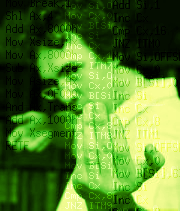 Once again, I'm stopped at a development cross-roads. Mostly due to IRL, admittedly, but stopped anyway. I decided to move back SEDS update to "not-a-priority" level as soon as I realised that I had no gameplay idea relying on slope angles variations in the school zone.
Once again, I'm stopped at a development cross-roads. Mostly due to IRL, admittedly, but stopped anyway. I decided to move back SEDS update to "not-a-priority" level as soon as I realised that I had no gameplay idea relying on slope angles variations in the school zone.
I have a "thread" of activity that insist on bringing life to the inkjet. Pixel art is ready, fundamental parts of the behaviour "should work", but it's not operational yet.
Par où continuer ? Les pentes supplémentaires, ce n'est pas franchement une priorité. J'ai bien progressé sur inkjet, j'ai du pixel art qui est prêt, mais ça chipotte un peu au niveau du GobScript. J'ai regardé de plus près le coup de la "corde qui pendouille" et couvert 2 ou 3 pages de formules et de schémas UML, mais pour le rendu, j'aurai certainement besoin du support 3D.
I invested some time into sorting out that "animated rope" thing, and I now have about 3 pages covered with UML diagrams, mathematicae formulae, code snippets and occasionally a gag featuring Bilou and Bouli. So the model and controller aspects are mostly solved. Yet, I haven't figured an obvious way to view the bookmarks that Bilou will hang on, so it starts depending on 3D layer as well, which in turn asks for pendats to come to live.
Alors, quitte à se taper la partie "3D", autant en profiter pour enfin amener le crayon-soldat sur le terrain, non ? Le hic c'est que mes dernières tentatives pour animer côte à côte Bilou et un de ces crayons n'ont pas franchement été convaincantes. Au point que j'hésite même sur la taille à donner au crayon. 40 pixels de haut, Bilou pourra sans trop de problèmes passer par-dessus. 48, c'est peut-être mieux, mais aussi peut-être trop haut pour les capacités actuelles de Bilou
 So I converted gbatek into an epub and started studying the options offered by NDS 3D rendering yesterday evening. That opens the door to some pendats, the long-awaited monsters that took over the Owl School. Meanwhile, I did some 2D attempts to animate a pendat, both in AnimEDS and later in flipnote studio, and I realised that I had no clear idea of the size pendat should have compared to Bilou. So far, Bilou should be able to clear a 40-pixels-high ennemy with a regular jump, and I don't know about a 48-px one, especially one like the pendat who cannot be jumped on.
So I converted gbatek into an epub and started studying the options offered by NDS 3D rendering yesterday evening. That opens the door to some pendats, the long-awaited monsters that took over the Owl School. Meanwhile, I did some 2D attempts to animate a pendat, both in AnimEDS and later in flipnote studio, and I realised that I had no clear idea of the size pendat should have compared to Bilou. So far, Bilou should be able to clear a 40-pixels-high ennemy with a regular jump, and I don't know about a 48-px one, especially one like the pendat who cannot be jumped on.
 There are only few scenes in Bilou's Book where Bilou faces a pendat directly. And none (iirc) with the desired proportions, neither for Bilou nor for the pendat. Yet, sketches suggest that Pendat.height > 2 Bilou.height
There are only few scenes in Bilou's Book where Bilou faces a pendat directly. And none (iirc) with the desired proportions, neither for Bilou nor for the pendat. Yet, sketches suggest that Pendat.height > 2 Bilou.height
Curieusement, je n'ai pas énormément de croquis de références. Dans tous, un pendat fait entre 2 et 3 Bilous de haut. Par contre, s'il est possible de passer par-dessus un pendat qui charge, mais de justesse, ce qui demande un timing quasi-parfait. L'idée étant évidemment d'encourager le joueur à se servir des dumbladors pour assommer les crayons ou de profiter d'un obstacle plus haut en bout de chemin de ronde.
Bref, le mieux, ce sera encore de faire le test: combien de fois parvenez vous à passer par-dessus le crayon, à gauche de la map avant de mourir (SchoolTest.nds)
 In my design documents, I clearly want that it is possible to clear a jump over a charging pendat, but also that it is tricky to do, requiring near-perfect timing when on flat ground.
In my design documents, I clearly want that it is possible to clear a jump over a charging pendat, but also that it is tricky to do, requiring near-perfect timing when on flat ground.
So let's try it out. Can we clear a jump over a 3-tile-high static pencil ? Is it interesting to have Bilou jumping slightly higher when he walks(/runs?) like in Super Mario Bros ? If so, is it interesting to have Bilou unable to jump over a pendat unless he walk-jump it ?
 (Et si vous allez vous promener à la gauche de la map, vous pouvez essayer de sauter par-dessus le crayon de 48 pixels pour remplir le Quizz de la semaine.)
(Et si vous allez vous promener à la gauche de la map, vous pouvez essayer de sauter par-dessus le crayon de 48 pixels pour remplir le Quizz de la semaine.)


















 Vote for your favourite post
Vote for your favourite post

